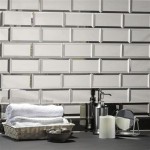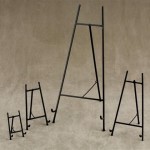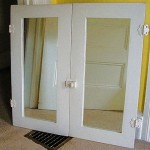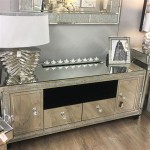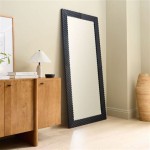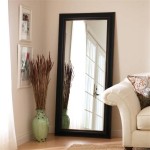Vintage Beveled Mirrors: A Reflection of Elegance and Craftsmanship
Vintage beveled mirrors represent a unique blend of functionality and artistry. Their reflective surfaces serve a practical purpose, while their intricate beveling adds a touch of elegance and historical significance to any space. Understanding the characteristics, history, and methods of identification can help appreciate these antique pieces fully.
Beveling, a technique of angling the edges of a mirror, creates a frame-like effect and plays with light and reflection. This process adds depth and dimension, transforming a simple mirror into a decorative element. The angle and width of the bevel can vary, influencing the overall aesthetic. Wider bevels often appear more dramatic, while narrower bevels offer a subtler enhancement.
The history of beveled mirrors is intertwined with the development of glassmaking and mirror production. Early methods of mirror making, involving mercury or tin and glass, were expensive and time-consuming. Beveling, initially achieved through laborious hand-grinding, further added to the cost and exclusivity of these items. Consequently, beveled mirrors were primarily found in the homes of the wealthy, often incorporated into ornate furniture pieces and architectural details.
The 19th and early 20th centuries witnessed significant advancements in glassmaking technology. Innovations like the silvering process, which replaced the toxic mercury backing, made mirrors more affordable and accessible. Simultaneously, the industrial revolution brought about mechanized methods of beveling, reducing production costs and increasing the availability of beveled mirrors to a wider population.
Despite these advancements, hand-beveling remained a specialized craft, particularly for intricate designs and high-quality pieces. Artisans continued to employ traditional techniques, creating bespoke mirrors with unique bevel patterns and elaborate detailing. These handcrafted mirrors represent a high level of craftsmanship and are highly sought after by collectors and antique enthusiasts.
Identifying a true vintage beveled mirror involves careful examination of several key factors. The glass itself offers important clues. Early mirrors often exhibit slight imperfections, such as bubbles or waves in the glass, due to the limitations of historical manufacturing processes. These imperfections, while considered flaws in modern mirror production, are often indicative of age and authenticity in vintage pieces.
The silvering on the back of the mirror can also provide insights into its age. Older silvering techniques often result in a slightly darker or mottled appearance compared to the uniform reflective surface of modern mirrors. Signs of foxing, or age-related spotting and discoloration of the silvering, can further suggest the mirror's vintage status.
Examining the bevel itself is crucial for authentication. Hand-beveled edges often display subtle irregularities and variations in the angle, a testament to the manual process. Machine-made bevels, particularly those from later periods, tend to be more uniform and precise. The presence of intricate patterns or detailing within the bevel itself often indicates hand-craftsmanship and adds to the mirror's value.
The frame, if present, can also provide clues to the mirror’s age and origin. Examining the materials, construction techniques, and stylistic details of the frame can help place the mirror within a specific historical period. Look for signs of age and wear on the frame, such as patina, scratches, or repairs, which can further support its authenticity.
The size and shape of the mirror can also contribute to its identification. Large, elaborately beveled mirrors were particularly popular during certain historical periods, such as the Victorian era. Oversized pier mirrors and ornate dressing table mirrors are examples of styles associated with specific timeframes.
Provenance, or the documented history of ownership, adds significant value and authenticity to a vintage beveled mirror. Auction records, estate sale documentation, or family histories can provide valuable information about the mirror's origins and previous owners. While provenance is not always available, it offers the strongest evidence of a mirror's authenticity and historical significance.
Caring for vintage beveled mirrors requires careful handling and appropriate cleaning methods. Avoid harsh chemicals and abrasive cleaners, which can damage the delicate silvering and the frame. Use a soft, lint-free cloth and a gentle cleaning solution specifically designed for mirrors or glass. When handling the mirror, support it from the back and avoid putting pressure on the beveled edges.
Proper storage and display are essential for preserving the condition of vintage beveled mirrors. Store the mirror in a dry, climate-controlled environment, away from direct sunlight and extreme temperature fluctuations. When hanging the mirror, ensure that it is securely mounted to prevent damage from falls or vibrations.

Vintage Etched Mirrors Mirror Frameless Beveled Without Frame

Vintage Thomasville Furniture Beveled Mirror Broe And Gold Tone Wall Medium Size

Large Vintage Beveled And Engraved Mirror At 1stdibs Antique Etched

Mirror Round Beveled Frameless Blue Birds Home Sweet Painted Vintage 18 Inch Diameter

Vintage English Beveled Mirror 1950s For At Pamono

Antique French Louis Xvi Gold Leaf Beveled Mirror 1890 For At Pamono

Vintage Octagon Bevelled Edge Mirror Alchemy

Vintage Cast Iron Beveled Mirror

Vintage Bevelled Wall Mirror With Carved Wood Frame

Vintage Mahogany Chippendale Beveled Mirror Chestnut Lane Antiques Interiors

